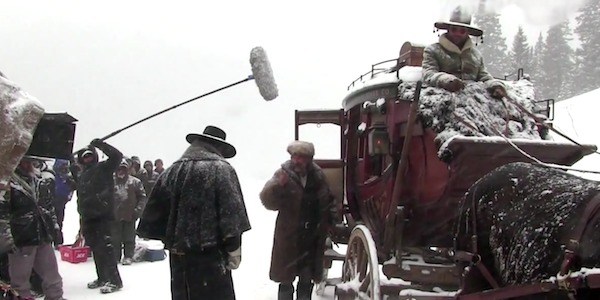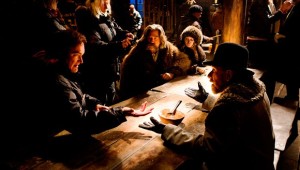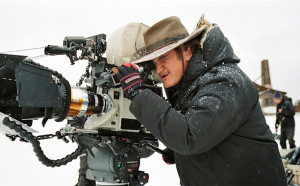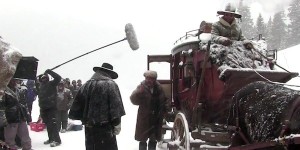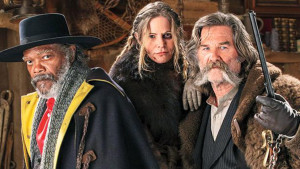With The Hateful Eight, writer-director Quentin Tarantino has crafted his second western in a row, after the Oscar winning Django Unchained. Technically, it’s his third period piece after Inglorious Bastards. When we caught up with the filmmaker at a recent press day for his latest, he had much to say about what it is that pulls his camera to the past in order to comment on the present.
“When you try to deal with prescient themes in the present, that is what you’re doing. That is the railroad you’re building, and that’s where that train is going. That can actually be fantastic. We can all point at versions in cinema history that have been profound,” Tarantino said.
“I do like putting scenario first. I do like putting story first. I like masking whatever I want to say in the guise of genres, so I can say it with my left hand and then deal with the right hand with what the genre dictates.”
Although he enjoys that ability of looking back to reflect on today, the auteur believes that Westerns create a whole new can of worms.
“There is no other genre that has dealt or deals with America better in a subtextual way than the Western being made in the different decades. The ‘50s Westerns very much put forth an Eisenhower idea of America and an American exceptionalism aspect of it, whereas the Westerns of the ‘70s were very cynical about America. It was a drag that that first draft of the script got out when it did. However, as we were making this movie, it was during that last year and a half where many of the themes that we were dealing with, we were watching on television when we got home,” he admitted.
“We would come to the set and we would talk about them. The one good thing about the script getting out there as soon as it did is I’m on record for having written this before all this shit started popping off in the last year and a half.”
The Academy Award winning filmmaker has managed to forge his own genre of filmmaking. He can change landscapes – modern day Los Angeles (Reservoir Dogs, Pulp Fiction), World War II (Inglorious Bastards) and Civil War-era Westerns (Django Unchained, The Hateful Eight) – yet they all share one thing in common and that is his pointed observations on modern society.
Some may say he is politically correct in his ability to bust stereotypes or in fact that he is the exact opposite. Tarantino doesn’t give that aspect of what he does much thought.
“I just don’t think about it that way. One can be inclined to just say, ‘Eff this political correctness. I don’t have time for that.’ But also, in polite society, there is such a thing as sensitivity to some issues as time has gone on. There was a time that we weren’t politically correct at all. And we all wince at moments when we look at the past and we see that. I don’t really know what the answer is as far as that is concerned,” Tarantino said.
“However, me as an artist, I don’t really think about it at all. It actually is not my job to think about that, and especially in terms of me as a writer, and also as a filmmaker. But I’m not worried about the filmmaking part, because if I’ve written it, that’s what I’m going to do. But particularly, as a writer, it is my job to ignore social critics or the response that social critics might have when it comes to the opinions of my characters, the way they talk, or anything that can happen to them.”
He cites the race issues that are prevalent in his last two films. Setting them after the Civil War allows Tarantino to broach these subjects with modern glasses. And given how authority figures (i.e. the police) are dominating headlines for how they are approaching African American suspects (how many blacks have been shot down by cops in the last several years?), it allows everyone who witnesses his films to have an opinion and a forum for a deeper societal discussion. But it is not simply about race. There has been some much publicized cases involving how women are treated. All of that controversial soup gets mixed up in The Hateful Eight and Tarantino doesn’t shy away from putting a spotlight on it.
“I mean, we can talk about the race stuff, which we actually talked about, but some people here sitting in the room might be uncomfortable about the violence that is handed out to Jennifer’s (Jason Leigh) character, and actually I’m playing with that in the course of the movie. When she gets that crack in the head by John Ruth (Kurt Russell) at the beginning of the movie, that is meant to send a shockwave out through the audience. You’re meant to think. You’re not necessarily meant to like Domergue (Leigh) in that moment, but you are meant to think that John Ruth is a brutal bastard at that moment, because that does seem like rather an overreaction to what she did and what she said,” Tarantino said.
“Now time goes on, and you see how you feel about the characters. But it’s meant to do that. There is this aspect of the way this story works in general, which is I have trapped eight people, actually nine people if you include O.B. (James Parks). He’s not part of the Hateful Eight because he’s not hateful. It’s the Hateful Eight and O.B.”
One of the things we adored most about Tarantino’s latest (as we explain in our The Hateful Eight review) is how the film works like a powder keg. You never know when it’s going to go off and who will become a casualty. That wasn’t always the case with the filmmaker’s other films where the violence permeated throughout.
“Anything can happen to these guys. Any piece of outrageous violence could happen to them. I paint in a system where there aren’t color book lines. I can cross those lines in the way that graphic novels – I don’t mean graphic novels as in a comic book – but the way that novels that deal with violence almost seem to go anywhere in a way that movies aren’t allowed to go,” Tarantino said.
Another aspect that makes The Hateful Eight so glorious is that the helmer shot it in 70mm. One of the challenges of shooting on this type of film is that previously, the canisters could only hold four minutes’ worth of film. Anyone who has ever seen a Tarantino film is keenly aware of its rich dialogue. Shooting at that rate would be frustrating to say the least. Thankfully, Panavision came through.
“Panavision came up with 2000-foot mags so we were able to shoot it for 11 minutes at a time. I can’t even imagine doing this material if we had to break it up in 4-minute goes. We had to do it like that. The Weinsteins were very generous with me. I didn’t have to dole out the footage in a certain way. I wasn’t completely cavalier about it, but I didn’t really change my shooting style for it. That would have been the idea to completely change my shooting style, so I shot the way I wanted to shoot,” he admitted.
The format did produce another challenge, but it proved to be a gift in hindsight. “The only real disadvantage I felt at the time, but then I don’t feel now, was we weren’t able to get a zoom lens, and I had really gotten used to using a zoom lens and the little zoom creep. But actually, that was also a nice thing to be forced to not use all the tools that you’ve gotten used to from time to time and be able to work in a different way.”
Tarantino has a clear fascination with the past and its interconnectivity with the present. Would he ever seek to make a film set in the future?
“That’s a really interesting idea. I don’t think anyone’s ever proposed it exactly the way you proposed it to me. Everyone always talks about the science fiction genre in particular, which always makes me think about people in spaceships. I can appreciate that, but that’s not really where I think my dramatist aspect lies. The way you posed it, I don’t think I’ve ever thought about it before, as far as dealing with a future society like ours,” Tarantino said.
“What would that entail? What would it mean to jump 20 years or 50 years or 100 years in the future and literally look at it from that point of view. I’ve never really thought about that before, but that is a profound thought, I have to admit.”

